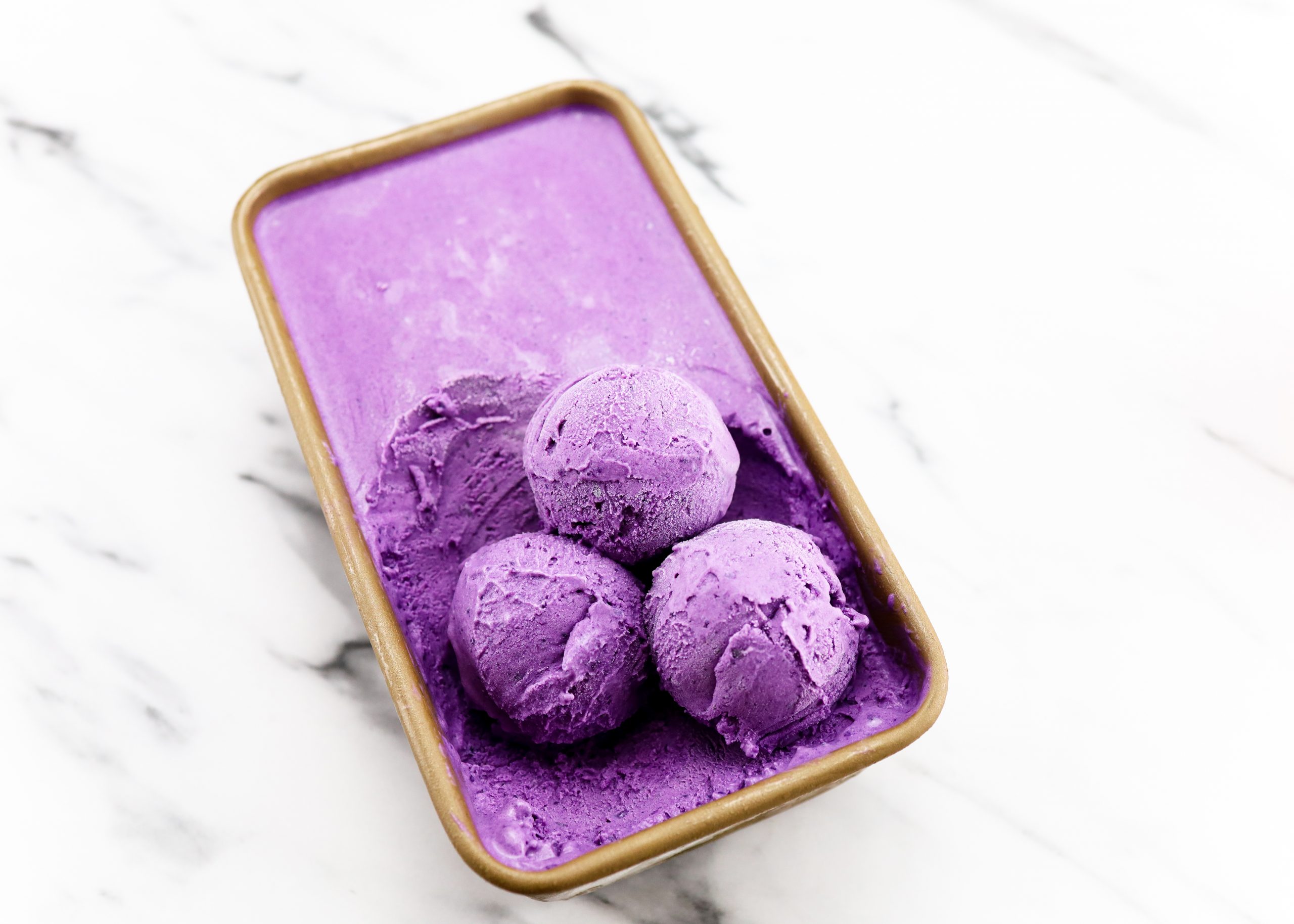Purple yams, commonly called ube, are nutrient-dense, adaptable, starchy tubers. They’re abundant in antioxidants that may assist in lowering both blood pressure and blood sugar.
Dioscorea alata is a species of yam often known as purple yam, ube, violet yam, or water yam.
This tuber originates in Southeast Asia and is frequently mistaken for taro. A traditional Filipino staple, it’s now grown and enjoyed in many regions around the globe.
Purple yams feature greyish-brown skins and vivid purple flesh, and when cooked their texture softens similarly to potatoes.
:strip_icc()/BHG-Ube-on-Purple-Background-3Yti-mUiaxY9Tlowh7CLLx-d933c42e8f7b4e4c80f6edd1f3e06794.jpg)
They offer a sweet, nutty taste and are incorporated into a broad array of dishes, both sweet and savory.
Additionally, they’re packed with vitamins, minerals, and antioxidants that may support your health.
Below are 7 noteworthy health advantages of purple yam.
1. Highly nutritious
Ube is a starchy root vegetable that provides carbohydrates, potassium, and vitamin C.
One cup (100 grams) of cooked ube delivers the following:
- Calories: 140
- Carbs: 27 grams
- Protein: 1 gram
- Fat: 0.1 grams
- Fiber: 4 grams
- Sodium: 0.83% of the Daily Value (DV)
- Potassium: 13.5% of the DV
- Calcium: 2% of the DV
- Iron: 4% of the DV
- Vitamin C: 40% of the DV
- Vitamin A: 4% of the DV
They also contain potent plant compounds and antioxidants, notably anthocyanins, which account for their striking color.
Research indicates that anthocyanins may help lower blood pressure and inflammation and offer protection against cancer and type 2 diabetes.
Moreover, purple yams are rich in vitamin C, which supports cell health, enhances iron absorption, and protects DNA from harm.
Summary Purple yams are starchy tubers rich in carbohydrates, potassium, vitamin C, and phytonutrients — all important for overall health.
2. Rich in antioxidants
Purple yams are abundant in antioxidants such as anthocyanins and vitamin C.
Antioxidants shield cells from damage caused by harmful molecules known as free radicals.
Free radical damage is associated with multiple chronic diseases, including cancer, heart disease, diabetes, and neurodegenerative disorders.
Vitamin C in purple yams functions as a strong antioxidant in the body.
Indeed, studies show that higher vitamin C intake can boost antioxidant levels by up to 35%, guarding against oxidative damage to cells.
The anthocyanins in purple yams are a class of polyphenol antioxidants.
Regular consumption of polyphenol-rich produce has been linked to reduced risks for several cancers.
Emerging research indicates that two anthocyanins in purple yams — cyanidin and peonidin — might inhibit the growth of certain cancers, including:
- Colon cancer. One animal study reported up to a 45% reduction in tumors with dietary cyanidin, while a lab study observed slowed growth of human cancer cells (15).
- Lung cancer. A laboratory study found that peonidin hampered lung cancer cell growth.
- Prostate cancer. Another in vitro study noted that cyanidin reduced human prostate cancer cell numbers.
However, these experiments used concentrated anthocyanins, so eating whole purple yams may not deliver identical effects.
Summary Purple yams provide anthocyanins and vitamin C, potent antioxidants that help prevent cellular damage and may protect against cancer.
3. May help manage blood sugar
Flavonoids found in purple yams have been shown to help lower blood glucose in models of type 2 diabetes.
Obesity and oxidative-stress-related inflammation raise the risk of insulin resistance, poor glucose control, and type 2 diabetes.
Insulin resistance occurs when cells respond poorly to insulin, the hormone that regulates blood sugar.
A laboratory study found that flavonoid-rich purple yam extracts reduced oxidative stress and insulin resistance by protecting insulin-producing pancreatic cells (19).
Additionally, a rat study showed that higher doses of purple yam extract reduced appetite, promoted weight loss, and improved glucose regulation (20).
Another study reported that a purple yam supplement slowed the absorption of sugar in rats with elevated glucose, leading to better glucose control (21).
Part of this effect is likely due to purple yams’ low glycemic index (GI). The GI (0–100) measures how rapidly carbohydrates raise blood sugar.
Purple yams have a GI of about 24, meaning their carbs are digested slowly, producing a gradual energy release rather than a sharp glucose spike (22).
Summary Flavonoids in purple yams may support blood sugar control in type 2 diabetes, and their low GI helps prevent rapid blood sugar rises.
4. May help lower blood pressure
High blood pressure is a leading risk factor for heart attacks and strokes.
Purple yams might help lower blood pressure, likely due to their high antioxidant content.
A lab study showed that antioxidants in purple yams may lower blood pressure via mechanisms similar to angiotensin-converting-enzyme (ACE) inhibitor drugs.
Another in vitro study indicated that these antioxidants could block the conversion of angiotensin I to angiotensin II, a peptide that raises blood pressure.
Although these findings are encouraging, they come from laboratory research. More studies in humans are necessary to determine whether eating purple yams lowers blood pressure.
Summary Lab research suggests antioxidant-rich purple yam extracts can lower blood pressure, but human trials are still needed.
5. May improve symptoms of asthma
Asthma is a chronic inflammatory condition affecting the airways.
Evidence indicates that diets high in antioxidants such as vitamins A and C are linked to a lower asthma risk.
A review of 40 studies found that adults with asthma tended to have low vitamin A intake, meeting roughly half the recommended daily amount on average (29).
Additionally, low dietary vitamin C corresponded to a 12% higher incidence of asthma.
Purple yams supply antioxidants and vitamins A and C, which can help you reach daily targets for these nutrients.
Summary Antioxidants like vitamins A and C in purple yams may help decrease the risk and severity of asthma symptoms.
6. Promotes gut health
Purple yams may support a healthy gut.
They contain complex carbohydrates and are a source of resistant starch — a form of carbohydrate that resists digestion.
A lab study showed that resistant starch from purple yams increased populations of Bifidobacteria, beneficial gut microbes, in a simulated colon environment.
These bacteria are essential for gut health, aiding the breakdown of complex carbs and fiber.
They may also lower the risk of conditions like colorectal cancer, inflammatory bowel disease (IBD), and irritable bowel syndrome (IBS), and they produce healthy short-chain fatty acids and B vitamins.
Moreover, one mouse study found that purple yams exerted anti-inflammatory effects and reduced symptoms of colitis.
However, more human research is required to confirm whether eating whole purple yams has anti-inflammatory benefits for people with colitis.
Summary Resistant starch in yams fosters the growth of Bifidobacteria, beneficial microbes that play a key role in gut health.
7. Very versatile
Purple yams are highly flexible in the kitchen.
They can be boiled, mashed, fried, or roasted, and they often substitute for other starchy vegetables in:
- stews
- soups
- stir-fries
In the Philippines, purple yams are milled into flour used in numerous desserts.
Additionally, ube can be processed into a powder that lends vibrant color to foods such as rice, candies, cakes, sweets, and jams.

In the Philippines, purple yams are milled into flour used in numerous desserts.
Summary Purple yams can be transformed into many forms, making them among the most versatile vegetables worldwide.
Purple yam vs. taro root
Taro root (Colocasia esculenta) is another root vegetable native to Southeast Asia.
Often called the tropical potato, taro ranges in color from white to grey to lavender and has a mildly sweet flavor.
Purple yams and taro can look alike, which leads to confusion, but their flesh colors differ once peeled.
Taro grows from the taro plant and is not one of the nearly 600 yam species.
Summary Taro root comes from the taro plant and, unlike purple yams, is not a true yam species.
The bottom line
Purple yams are highly nutritious starchy tubers.
Their robust antioxidants may help lower blood pressure and blood sugar.
They’re flavorful and adaptable, with a vivid color that makes them an appealing ingredient for many sweet and savory recipes.


















Leave a Reply
You must be logged in to post a comment.